White Sands National Park stands as one of America’s most otherworldly destinations, where waves of brilliant white gypsum sand stretch endlessly across the Tularosa Basin in southern New Mexico.¬
This remarkable landscape, spanning over 275 square miles, represents the largest gypsum dunefield in the world and offers visitors an experience unlike anywhere else on Earth. The park’s creation story dates back millions of years when ancient seas left behind layers of gypsum that eventually transformed into these pristine white dunes through wind and water erosion.
Located just 15 miles southwest of Alamogordo and approximately 50 miles northeast of Las Cruces, White Sands National Park provides easy access for travelers exploring the American Southwest.¬
The park’s proximity to these gateway cities makes it an ideal destination for both day trips and extended adventures. El Paso, Texas, sits just 90 miles to the south, while Roswell lies 75 miles to the northeast, making White Sands a perfect addition to any New Mexico road trip itinerary.
Things to Do in White Sands National Park
1. Experience the Magic of Dune Sledding
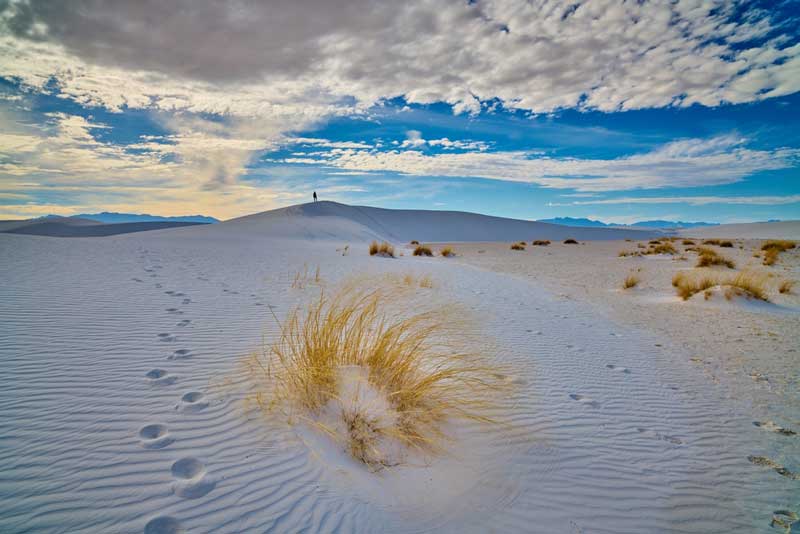
White Sands National Park
Dune sledding is a top activity at White Sands, offering joy for all ages. The soft gypsum sand provides a perfect surface for sliding, feeling like winter sledding in the desert. Unlike regular sand, gypsum doesn’t retain heat, making it comfortable even in summer. The park gift shop sells specialized sand discs.
Best sledding spots are along the Alkali Flat Trail and near picnic areas with larger dunes for longer rides. Children and adults alike enjoy racing down the pristine white slopes. For optimal conditions, visit during cooler parts of the day when sand is more compact. No special skills are needed, making it accessible to everyone.
Safety tips include staying hydrated, wearing sunscreen, and avoiding extreme heat. Park rangers recommend ample water and shade breaks. Sledding equipment can be bought at the visitor center or you can bring your own smooth-bottomed sleds. Remember to pace yourself climbing dunes between runs.
2. Capture Stunning Sunset and Sunrise Photography
White Sands National Park offers spectacular sunset and sunrise photography opportunities in the American Southwest. The interaction of white gypsum dunes and changing sky colors creates dramatic scenes photographers cherish. During golden hour, dunes glow in warm amber and pink, while surrounding mountains provide striking purple and blue backdrops.
Top photography locations include the Interdune Boardwalk for easy access, Dune Life Nature Trail for close-ups, and backcountry areas via Alkali Flat Trail for dramatic compositions. Professionals often prefer early mornings for softer light and minimal crowds. The contrast between white sand and colorful sky naturally balances exposures for any camera.
Photography tips include using a polarizing filter to reduce glare, protecting camera equipment from sand, and bracketing exposures for full dynamic range. The reflective gypsum can trick light meters, so manual exposure often yields better results. Bring extra batteries, as extreme temperatures drain power quickly. Consider different seasons for varying atmospheric conditions and dramatic storm clouds.
3. Hike the Alkali Flat Trail for Backcountry Adventure
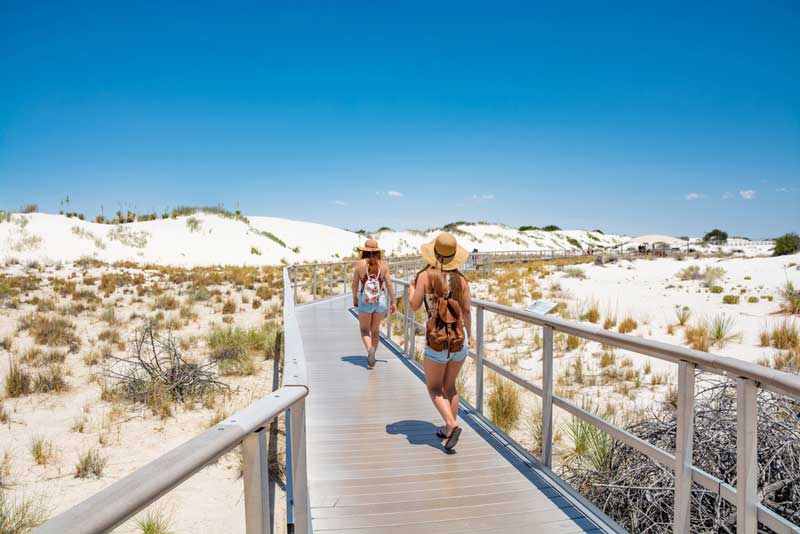
The Alkali Flat Trail offers White Sands National Park’s most challenging and rewarding hike, venturing 4.6 miles round-trip into the heart of the constantly shifting dunefield. Following orange markers, this trail provides an authentic backcountry desert experience, offering solitude and pristine wilderness far from more accessible areas.
Careful attention to numbered markers is crucial for navigation, as shifting sands can obscure the path. The trail leads to an ancient lake bed, ideal for wildlife viewing, especially during early mornings and late afternoons. Walking across the seemingly endless white dunes creates a deeply moving, meditative experience.
Preparation for this strenuous hike is essential: bring at least one gallon of water per person, wear protective clothing, and start early to avoid heat. The soft sand makes walking challenging, so allow extra time. While GPS can be helpful, the marked trail generally provides sufficient guidance. Always check current conditions with park rangers, as weather can affect accessibility and safety.
4. Explore the Dune Life Nature Trail for Wildlife Discovery
The Dune Life Nature Trail is an easy, one-mile loop offering an accessible introduction to White Sands’ unique ecosystem. Interpretive signs explain how plants and animals adapt to the gypsum environment, with boardwalk sections providing wheelchair accessibility.
Wildlife like the bleached earless lizard and Apache pocket mouse have evolved lighter coloration to blend with the white sand. Early mornings and late afternoons are best for wildlife viewing, when animals are most active in cooler temperatures. The trail also highlights plant adaptations like four o’clock flowers and soaptree yucca.
This trail is highly valuable for families, with interpretive signs explaining ecological concepts simply. A visitor center guide offers more on the dunes’ geology and park research. Photography opportunities abound, with close-up views of desert flora and potential wildlife sightings.
5. Attend a Full Moon Night Program¬
White Sands National Park’s monthly full moon programs offer a magical experience, transforming the landscape into an ethereal wonderland. Visitors can explore the dunes under natural moonlight, as the white gypsum sand reflects the moon’s light, creating comfortable nighttime visibility.
Programs include guided walks, talks on nocturnal wildlife, and stargazing under the park’s dark skies. Rangers share insights into desert animals active after dark, offering chances to spot creatures not seen during the day. Cooler nighttime temperatures make for comfortable extended outdoor activities.
Advance reservations are required for these popular, often sold-out programs. Participants should bring flashlights with red filters, warm clothing for desert temperature drops, and comfortable shoes. These programs combine education, adventure, and natural beauty for lasting memories. Check the park’s website for dates and booking information.
6. Visit the Interdune Boardwalk for Accessible Exploration
The Interdune Boardwalk provides an excellent, accessible introduction to White Sands, ideal for visitors with mobility challenges. This 0.4-mile boardwalk winds through dunes and interdune areas, offering spectacular views and educational insights without strenuous hiking. The elevated walkway protects the fragile ecosystem while providing close-up views.
Interpretive signs explain the dunes’ geological processes, the desert’s water cycle, and specialized plant survival. The boardwalk’s design accommodates wheelchairs and strollers, allowing access to otherwise difficult-to-reach areas. Photography is excellent, with elevated perspectives offering unique angles of the dunes’ flowing patterns.
This boardwalk serves as a great starting point for first-time visitors, offering a taste of the park before more challenging areas. Early morning and late afternoon visits provide optimal lighting for photography and wildlife viewing. Its minimal environmental impact highlights the park’s dedication to preservation and public access.
7. Discover the Backcountry Camping Experience
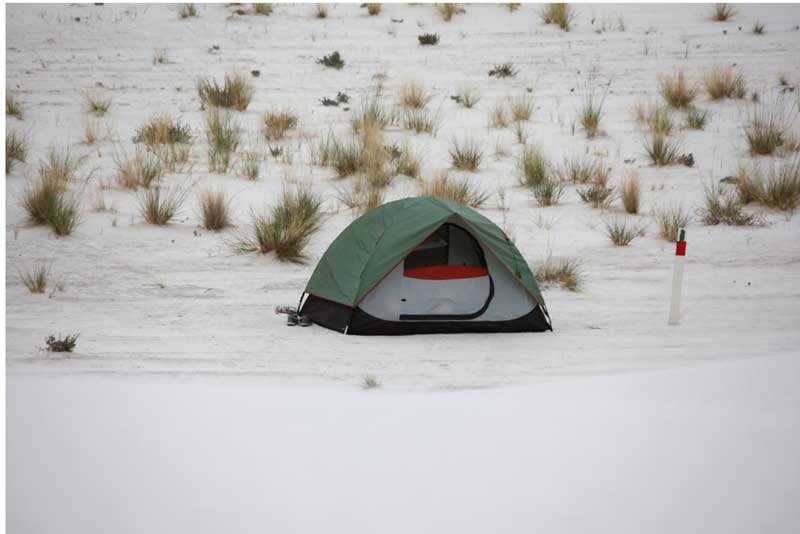
Backcountry camping in White Sands National Park offers an unparalleled wilderness experience, sleeping under star-filled skies amidst pristine white dunes. The park’s program allows small groups to venture deep into the dunefield for overnight adventures, with campsites roughly one mile from the road for solitude.
Camping includes spectacular sunset and sunrise views, unobstructed stargazing, and witnessing the desert’s nocturnal transformation. As temperatures drop, the white sand glows mystically under moonlight and stars. The desert’s silence, broken only by wildlife, offers a peaceful retreat.
Permits are required and must be obtained in advance. Campers must pack out all trash and follow Leave No Trace principles. Essential gear includes sturdy wind-resistant tents, ample water, and warm sleeping bags. This physically demanding experience for hiking with packs rewards with memorable camping in the National Park System.
8. Join a Ranger-Led Program for Educational Insights¬
White Sands National Park offers diverse ranger-led programs providing expert insights into the park’s geology, ecology, and cultural history. These educational programs cover topics from dune formation to Native American significance, with engaging presentations bringing the landscape’s story to life.
Programs vary seasonally, including guided walks, evening talks, and special events. Rangers’ expertise adds depth, explaining complex scientific concepts and sharing fascinating stories about park research and conservation. These programs often reveal hidden aspects independent visitors might miss.
Participating in ranger programs deepens understanding of the park’s fragile ecosystem and preservation efforts. Programs are typically free with admission, offering great educational value for families. Check the park’s website or visitor center for current schedules, as offerings change seasonally.
9. Experience the Plant and Animal Life Trail
The Plant and Animal Life Trail offers an intimate look at remarkable adaptations allowing life to flourish in the harsh gypsum environment. This moderate trail showcases diverse species, from soaptree yucca to the bleached earless lizard, explaining their unique survival strategies.
Wildlife viewing includes various lizards, desert birds, and small mammals adapted to the white environment, many with lighter coloration. The trail also highlights plant survival strategies like deep roots and water storage.
The trail’s educational value goes beyond observation, encouraging consideration of broader ecological principles and conservation. Photography opportunities abound for wildlife and plant enthusiasts, with macro shots revealing intricate desert adaptations. Its moderate difficulty makes it accessible while offering a sense of adventure.
10. Participate in the Lake Lucero Tours¬
Lake Lucero tours provide access to one of White Sands National Park’s most restricted and scientifically important areas: the ongoing formation of gypsum crystals. These guided monthly tours (conditions permitting) lead visitors to the ancient lake bed, the source of the park’s white sand, where gypsum continues to crystallize.
The tour includes a moderate hike to the lake bed, where seasonal water forms a temporary lake crucial to dune formation. Rangers explain the complex geological and hydrological processes. The area’s restricted access preserves its scientific value while allowing limited public appreciation of this natural laboratory.
Tours require advance registration and are limited to small groups. Participants should be prepared for a 2-3 hour commitment with moderate hiking and sun exposure. The educational value is exceptional, offering firsthand observation of ongoing geological processes. Check the park’s website for schedules and reservation requirements.
11. Enjoy Picnicking in the Desert Oasis¬
White Sands National Park’s picnic areas offer welcome respite from the desert sun with spectacular dune views. The main picnic area provides covered tables, restrooms, and grills, ideal for families to dine amidst the unique landscape. The contrast between amenities and wild dunes creates a memorable experience.
Strategically placed picnic areas offer wind protection while maintaining views of the ever-changing dunes. Many visitors combine picnicking with other activities, using areas as base camps for sledding or hiking. Facilities accommodate various group sizes, though reservations might be needed for large events.
Planning picnic visits requires considering weather, temperature, and wind. Essential items include extra water and sun protection, as the desert can be dehydrating. Picnic areas provide an excellent, comfortable introduction to the park for families with young children.
12. Marvel at the Gypsum Crystal Formations
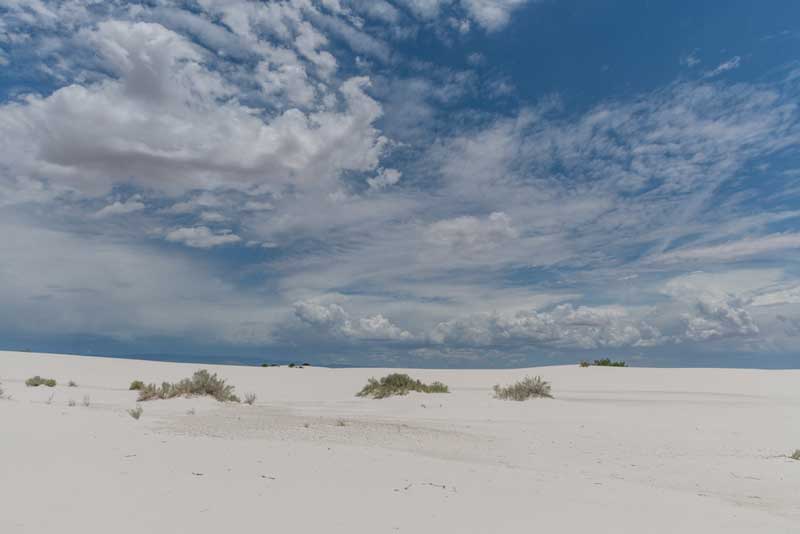
Gypsum crystal formations throughout White Sands National Park narrate the story of ancient seas, geological upheaval, and ongoing natural processes. These crystalline structures, from tiny particles to large selenite formations, offer insights into the park’s unique geological history. Visitors can observe them along various trails, with impressive examples in backcountry areas.
The crystals demonstrate the water cycle’s role in the desert, as seasonal moisture dissolves and recrystallizes gypsum, creating the constantly changing landscape. Formations also support unique microhabitats, providing shelter and resources for specialized plants and animals in a harsh environment.
Photography enthusiasts find crystals rewarding subjects, as light and mineral interplay create stunning visuals. Macro photography reveals intricate details, while wider shots capture their relationship to the landscape. Visitors must observe Leave No Trace principles, as formations are crucial to the ecosystem and easily damaged.
13. Participate in Citizen Science Programs¬
White Sands National Park offers citizen science programs, allowing visitors to contribute to ongoing research and deepen their understanding of the unique ecosystem. These hands-on programs cover wildlife monitoring to vegetation studies, providing opportunities to participate in scientific research. Visitors contribute valuable data while gaining insight into preservation methods.
Programs often focus on species adaptation, climate change impacts, and ecosystem health indicators requiring long-term data. Participants receive training on data collection and scientific principles. These programs demonstrate how national parks serve as natural laboratories for understanding environmental changes and developing conservation strategies.
Participation fosters a deeper connection to the park and its conservation mission. Visitors gain enhanced appreciation for desert ecosystems and ongoing preservation efforts. Programs also provide educational value for families and student groups, illustrating how research contributes to our understanding of natural systems.
14. Explore the Historic and Cultural Sites¬
White Sands National Park preserves natural wonders alongside significant cultural and historical sites, revealing human interaction with this unique landscape. The area’s cultural history spans millennia, from ancient Native Americans to modern military testing, leaving traces that enrich the park’s interpretive story. Archaeological sites provide evidence of human adaptation to the desert.
The park’s 2019 national park designation elevated protection for these cultural resources. Visitor center exhibits and interpretive programs provide context for understanding the human dimension. Cultural sites demonstrate how different peoples utilized and appreciated the gypsum environment’s unique resources.
Visitors interested in cultural history can explore these themes through ranger programs, exhibits, and self-guided materials. Cultural sites add depth, illustrating how the landscape shaped human activities and how humans influenced the environment. Respectful visitation helps preserve their integrity and provides educational opportunities.
15. Witness the Seasonal Wildflower Displays
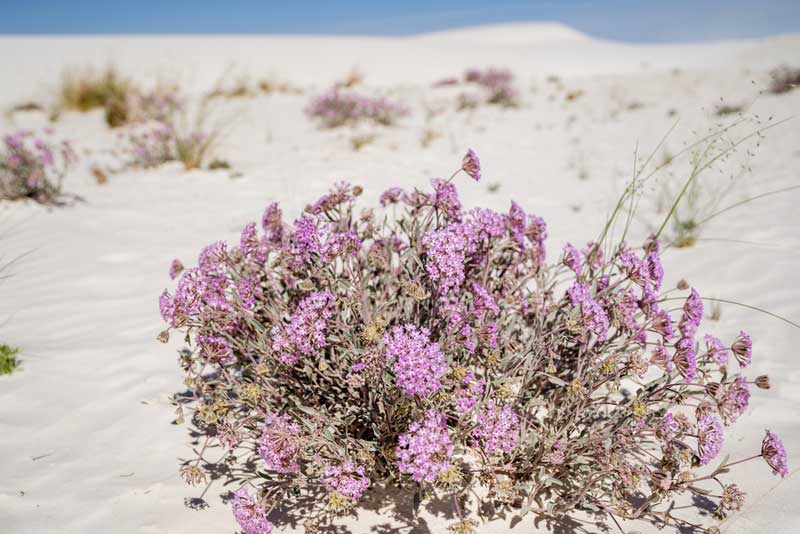
White Sands National Park’s seasonal wildflower displays transform the stark landscape into a colorful spectacle, showcasing desert life’s resilience and beauty. These blooms typically occur in spring and fall, when moisture and favorable temperatures trigger cycles. The contrast between delicate flowers and the harsh gypsum creates striking visual displays for photographers and nature enthusiasts.
Wildflower displays vary annually based on precipitation and temperature, making each season unique. Common species include desert marigold, four o’clock, and various cacti. Spring blooms usually appear from March to May, and fall blooms from September to November, depending on weather.
Photography opportunities are exceptional during wildflower season, with the white sand perfectly contrasting colorful blooms. Displays also attract pollinators, offering additional wildlife viewing. Visitors planning trips for wildflowers should check the park for current conditions, as displays can be unpredictable.
Meet the top attractions in USA, here is a guide on the top things to do in Zion National Park and the things to do in Charleston.
Local Travel Tips for Visiting White Sands National Park
Getting There and Transportation
White Sands National Park is easily accessible by car from several major cities in the Southwest. The park entrance is located on US Highway 70, approximately 15 miles southwest of Alamogordo, New Mexico. Visitors traveling from El Paso, Texas, can reach the park in about 90 minutes via US Highway 70 east. Those coming from Albuquerque should plan for a 4-hour drive south via Interstate 25 and US Highway 380.
The park’s location makes it an ideal addition to Southwest road trip itineraries, with easy connections to other attractions like Carlsbad Caverns National Park (3 hours northeast) and Big Bend National Park (5 hours southeast). Las Cruces, New Mexico, serves as another gateway city about 50 miles southwest of the park, offering additional lodging and dining options. Public transportation to the park is limited, making a rental car the most practical option for most visitors.
Inside the park, the 8-mile Dunes Drive provides access to all major attractions and trailheads. The paved road is suitable for most vehicles, though sand occasionally drifts across the pavement during windy conditions. Park rangers regularly maintain the road, but visitors should drive cautiously and be prepared for reduced visibility during sandstorms. The road typically closes briefly during missile tests at the nearby White Sands Missile Range, which occur 2-3 times per year.
Where to Stay and Nearby Accommodations
Alamogordo offers the closest lodging options to White Sands National Park, with various hotels, motels, and bed-and-breakfast establishments within 15 miles of the park entrance. The city provides familiar chain hotels as well as locally-owned accommodations that offer personalized service and local knowledge. Most Alamogordo hotels provide amenities like pools, continental breakfast, and Wi-Fi, making them suitable for families and business travelers.
Las Cruces presents additional accommodation options for visitors willing to drive a bit further for more variety and amenities. The city offers everything from budget motels to luxury resorts, along with vacation rentals that can accommodate larger groups. Las Cruces also provides more dining and entertainment options, making it suitable for extended stays that include exploration of other regional attractions.
For those seeking a more adventurous experience, the park’s backcountry camping program offers primitive camping deep in the dunes. This option requires advance reservations and appropriate gear but provides an unparalleled wilderness experience. RV camping is not available within the park, but several private campgrounds in the Alamogordo area cater to recreational vehicle travelers.
Best Times to Visit
White Sands National Park offers year-round visitation opportunities, but timing can significantly impact your experience. Spring (March-May) and fall (September-November) provide the most comfortable weather conditions, with moderate temperatures and occasional wildflower displays. These seasons offer ideal conditions for hiking, photography, and extended outdoor activities without the extreme heat of summer or the occasional cold snaps of winter.
Summer visits (June-August) require careful planning due to high temperatures that can exceed 100¬įF. Early morning and late afternoon activities work best during summer months, with midday hours reserved for indoor activities or rest. The summer season does offer extended daylight hours and spectacular thunderstorm displays that create dramatic photography opportunities. Visitors should prioritize hydration and sun protection during summer visits.
Winter (December-February) brings cooler temperatures and occasional snow that creates stunning contrasts with the white dunes. While temperatures can drop below freezing at night, daytime conditions often remain pleasant for outdoor activities. Winter visits offer unique photographic opportunities and fewer crowds, though some programs and activities may have reduced schedules. Check park conditions before winter visits, as weather can occasionally impact road conditions and program availability.
What to Pack and Preparation Tips
Successful visits to White Sands National Park require thoughtful preparation for the unique desert environment. Essential items include plenty of water (at least one gallon per person per day), broad-spectrum sunscreen with high SPF, and protective clothing including wide-brimmed hats and sunglasses. The reflective white sand intensifies sun exposure, making protection more critical than in typical desert environments.
Comfortable, closed-toe shoes are essential for hiking and walking on the sand, as the gypsum particles can work their way into sandals and cause discomfort. Light-colored clothing helps reflect heat and provides better sun protection than dark colors. Bring layers for temperature variations, as desert nights can be surprisingly cool even during hot days.
Photography equipment should include extra batteries, memory cards, and protective covers for cameras and lenses. The sand is fine and can infiltrate electronic equipment, so proper protection is essential. Bring cash for park entry fees and gift shop purchases, as card processing may be limited. Consider packing a small cooler with snacks and drinks, as food service options within the park are limited.
Explore the top attractions in USA, here is a guide on the top things to do in Manchester and the things to do in Sharon Springs.
Frequently Asked Questions
How much does it cost to visit White Sands National Park?
The entrance fee for White Sands National Park is $25 per vehicle for a 7-day pass, making it an affordable destination for families and groups. Annual passes specific to White Sands are available for $45, while the America the Beautiful National Parks Annual Pass ($80) provides access to all national parks and is cost-effective for visitors planning to visit multiple parks within a year. Military personnel, seniors, and individuals with permanent disabilities qualify for discounted or free passes.
The park accepts cash, credit cards, and debit cards for entrance fees, though it’s wise to bring cash as backup in case of technical issues with card processing. The entrance fee covers access to all trails, programs, and facilities within the park. Additional costs may include purchases from the gift shop, equipment rentals for activities like sledding, and fees for special programs like backcountry camping permits.
What should I bring for a day trip to White Sands?
A successful day trip to White Sands requires careful preparation for the unique desert environment. Essential items include at least one gallon of water per person, high-SPF sunscreen, wide-brimmed hats, and sunglasses to protect against the intense reflected sunlight from the white sand. Comfortable walking shoes are crucial, as the gypsum sand can work its way into sandals and cause discomfort during extended activities.
Additional recommended items include snacks and lunch (as food service options are limited), a first aid kit, extra batteries for cameras and phones, and layers of clothing for temperature variations. If you plan to try dune sledding, you can purchase sand discs at the visitor center or bring your own smooth-bottomed sleds. A small cooler can help keep drinks and snacks cool in the desert heat.
Are there any safety concerns I should know about?
White Sands National Park presents unique safety challenges that visitors should understand before exploring. The primary concerns include dehydration, sun exposure, and navigation difficulties in the trackless dune environment. The white sand reflects sunlight intensely, increasing the risk of sunburn and heat-related illnesses even on cloudy days. Visitors should drink water regularly, wear protective clothing, and seek shade during the hottest parts of the day.
Navigation can be challenging in the backcountry areas where shifting sands obscure landmarks and trails. Visitors should stay on marked trails, carry maps and GPS devices, and inform others of their planned routes. The park occasionally closes during missile tests at the adjacent White Sands Missile Range, typically 2-3 times per year with advance notice provided on the park website.
Wildlife encounters are generally minimal, but visitors should be aware of rattlesnakes and other desert creatures. Most animals are nocturnal and avoid human contact, but maintaining awareness and making noise while hiking helps prevent surprise encounters. Flash floods can occur during monsoon season, making it important to avoid low-lying areas during thunderstorms.
Conclusion
White Sands National Park offers an extraordinary combination of natural beauty, outdoor adventure, and educational opportunities that create lasting memories for visitors from around the world. From the simple joy of sledding down pristine dunes to the profound experience of camping under star-filled skies, the park provides activities that appeal to every type of traveler.¬
The unique gypsum landscape serves as both playground and classroom, offering insights into geological processes, desert ecology, and the remarkable adaptations that allow life to thrive in challenging environments.
